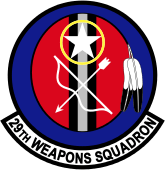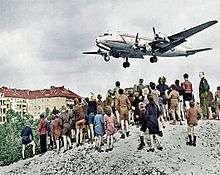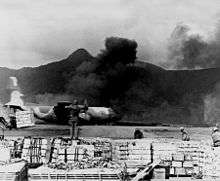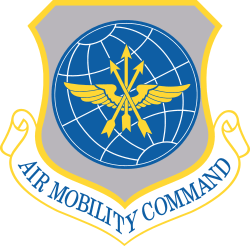29th Weapons Squadron
29th Weapons Squadron
 | |
|---|---|
|
A C-130 Hercules from Little Rock, Air Force Base, Arkansas | |
| Active | 1942-1945; 1946-1949; 1953-1955; 1964-1971; 2003-present |
| Country |
|
| Branch |
|
| Role | Airlift operational testing |
| Part of | USAF Weapons School |
| Garrison/HQ | Little Rock Air Force Base, Arkansas |
| Nickname(s) | F Troop (Vietnam era)[1] |
| Engagements |
European Theater Vietnam War |
| Decorations |
Distinguished Unit Citation Air Force Outstanding Unit Award with Combat "V" Device Air Force Outstanding Unit Award Vietnamese Gallantry Cross with Palm |
| Insignia | |
| 29th Weapons Squadron emblem (Approved 28 October 2003)[2] |
 |
| 29th Tactical Airlift Squadron emblem (Approved 24 August 1943)[3][note 1] |
 |
| Emblem used by the 29th Troop Carrier Squadron in the 1950s. |
 |
| Fuselage code while in European Theater[4] | 5X |
The 29th Weapons Squadron is a United States Air Force unit, stationed at Little Rock Air Force Base, Arkansas. It is assigned to the USAF Weapons School at Nellis Air Force Base. The mission of the squadron is to provide advanced Lockheed C-130J Hercules instructional flying.
The squadron was first activated in 1942 as the 29th Transport Squadron. After training in the United States, it deployed to the Mediterranean Theater of Operations as the 29th Troop Carrier Squadron. The squadron dropped paratroopers in the invasions of Sicily and Italy before moving to England. From England it participated in Operation Overlord. The 29th earned two Distinguished Unit Citations for combat actions. Following VE Day, the squadron returned to the United States where it was inactivated In September 1945.
The squadron was activated again in September 1946 and served with the occupation forces in Italy and Austria before returning to the United States in 1947. In 1948 the squadron moved to Germany, where it participated in the Berlin Airlift until being inactivated in 1949 as American airlift forces in Germany were reduced after the blockade of Berlin was ended. The squadron was activated again at Mitchel Air Force Base in February 1953, when it assumed the resources of the 335th Troop Carrier Squadron, a reserve unit that had been activated for the Korean War, and which was returning to reserve status. The squadron was inactivated in June 1955.
The squadron was again activated in October 1964 at Forbes Air Force Base, Kansas. In December 1965, the squadron moved to Clark Air Base, Philippines, from which it deployed its Lockheed C-130 Hercules transports to support the Vietnam War. In 1971, it moved on paper to Langley Air Force Base, Virginia, where it again worked up on the C-130. Shortly after it became combat ready, however, it was inactivated and its personnel and aircraft were transferred to the 38th Tactical Airlift Squadron, which was simultaneously activated.
Mission
The 29th Weapons Squadron conducts graduate-level instruction in weapons and tactics employment with the Lockheed C-130J Hercules.[5] A detachment of the squadron at Rosecrans Field performs the same mission for Air National Guard and Air Force Reserve C-130H crews.[6]
History
World War II

The squadron was activated as the 29th Transport Squadron in March 1942 as one of the original squadrons of the 313th Transport Group under Air Transport Command (later I Troop Carrier) Command) and equipped with Douglas C-47 Skytrain aircraft and other military models of the Douglas DC-3, including the C-53 Skytrooper. It trained in the southeastern United States.[2][7]
The squadron, now named the 29th Troop Carrier Squadron, moved to Oujda Airfield, French Morocco after the Operation Torch landings. It performed airlift of supplies and personnel to ground forces advancing though Algeria into Tunisia as part of Twelfth Air Force. The unit also evacuated wounded personnel to rear areas.[7]
The squadron trained for Operation Husky, the invasion of Sicily and entered combat on the night of 9 July 1943 by dropping paratroops near Gela. The squadron was attacked by antiaircraft fire from friendly ground and naval forces while carrying reinforcements to Sicily on the night of 11 July, but completed its mission. The unit received a Distinguished Unit Citation for this action. It moved to Sicily for Operation Avalanche, the invasion of Italy. It dropped paratroopers of 82d Airborne Division south of Salerno on the night of 13 September 1943 and flew a reinforcement mission the following night.[7]

The squadron resumed transport activities in the Mediterranean until February 1944, when it moved to RAF Folkingham, England where it joined IX Troop Carrier Command. It prepared for Operation Overlord, the Normandy invasion and on D-Day, 6 June 1944, it released paratroops near Picauville. It dropped reinforcements over the same area on 7 June 1944, earning its second Distinguished Unit Citation.[7]
The squadron dropped paratroopers near Arnhem and Nijmegen on 17 September during Operation Market Garden, the airborne attack on the Netherlands and released gliders carrying reinforcements to that area on 18 and 23 September. The squadron moved to France in March 1945, and received Curtiss C-46 Commandos, which it used in Operation Varsity, the airborne assault across the Rhine River. The squadron dropped paratroops of 17th Airborne Division near Wesel on 24 March. When not engaged in airborne operations the group evacuated wounded personnel and ex-prisoners of war, and also transported cargo such as ammunition, gasoline, medical supplies, and food until after V-E Day.[7]
In August 1945 the squadron returned to the United States, and was inactivated at the Port of Embarkation in September.[2]
Army of Occupation and Berlin Airlift

The squadron was activated at Capodichino Airport near Naples, Italy at the end of September 1946, absorbing the mission, personnel and equipment of the 305th Troop Carrier Squadron, which was simultaneously inactivated.[8] It once again was equipped with C-47s. The squadron briefly moved to Tulln Air Base, Austria in the spring of 1947.[2]
The squadron transferred without personnel and equipment to the States in June 1947. At Bergstrom Field, Texas it trained with Fairchild C-82 Packets and gliders. The squadron departed Bergstrom for in late October 1948 for Germany, arriving in early November to reinforce airlift units in Operation Vittles, the Berlin airlift. Operating from a Royal Air Force base because of congestion at United States Air Forces Europe bases in Germany, the unit used Douglas C-54 Skymasters to transport cargo including coal, food, and medicine into West Berlin. As airlift forces in Europe were reduced following the airlift, the squadron was inactivated in September 1949.[7][9]
Cold War
.jpg)
The squadron was activated at Mitchel Air Force Base, New York in February 1953, assuming the personnel and Fairchild C-119 Flying Boxcars of the 335th Troop Carrier Squadron, an Air Force Reserve unit that had been called to active duty for the Korean War and was transitioning to the C-119 from the Curtiss Commando.[10] The squadron trained to maintain combat readiness in tactical airlift operations. It was inactivated on 8 June 1955.[2]
Vietnam War

The squadron was reactivated at Forbes Air Force Base, Kansas in 1964, flying Lockheed C-130 Hercules.[2] In March 1965, the 29th became the first combat-ready unit of Tactical Air Command at Forbes. It then assumed a commitment to rotate aircraft to the Panama Canal Zone. The squadron frequently deployed to support airlift requirements of overseas commands, participate in tactical exercises and disaster relief.
In December 1965 the squadron left Forbes for Clark Air Base, Philippines, arriving in late January 1966 to perform theater airlift in Southeast Asia as part of 315th Air Division.[2] The unit deployed aircraft and crews to provide intra-theater airlift for United States military civic actions, combat support and civic assistance throughout the Republic of Vietnam, particularly from the C-130 operating location at Tan Son Nhut Airport outside Saigon. In May 1969, the unit assumed the Commando Vault mission, dropping a 10,000-pound bomb designed to clear helicopter landing zones out of jungle from its cargo bay.[2] The squadron was inactivated in October 1970[2] and its remaining aircraft and crews were distributed among the 463d Tactical Airlift Wing's other squadrons.
The squadron was reactivated in April 1971 at Langley Air Force Base, Virginia and began training with C-130s. Shortly after becoming combat ready, in November its mission, equipment and personnel were transferred to the 38th Tactical Airlift Squadron and the 29th was inactivated.[2]
Weapons system training
The squadron was redesignated the 29th Weapons Squadron and reactivated in June 2003 at Little Rock Air Force Base, Arkansas as part of the USAF Mobility Weapons School and equipped with C-130 Hercules. The squadron was reassigned to the USAF Weapons School at Nellis Air Force Base, Nevada in 2006.[2] In August 2014 the squadron established a detachment at Rosecrans Field, Missouri to conduct the Weapons Instructor Course for Air National Guard and Air Force Reserve aircrews flying the C-130H. The 29th elements at Little Rock will then concentrate on the Weapons Instructor Course for the C-130J.[6]
Lineage
- Constituted as the 29th Transport Squadron on 28 January 1942
- Activated on 2 March 1942
- Redesignated 29th Troop Carrier Squadron on 4 July 1942
- Inactivated on 22 September 1945
- Activated on 30 September 1946
- Redesignated: 29th Troop Carrier Squadron, Heavy on 30 July 1948
- Redesignated: 29th Troop Carrier Squadron, Special on 1 February 1949
- Inactivated on 18 September 1949
- Redesignated 29th Troop Carrier Squadron, Medium on 26 November 1952
- Activated on 1 February 1953
- Inactivated on 8 June 1955
- Activated on 15 June 1964 (not organized)
- Organized on 1 October 1964
- Redesignated 29th Troop Carrier Squadron on 1 January 1967
- Redesignated 29th Tactical Airlift Squadron on 1 August 1967
- Inactivated on 31 October 1970
- Activated on 1 April 1971
- Inactivated on 15 November 1971
- Redesignated 29th Weapons Squadron on 30 May 2003
- Activated on 1 June 2003[2]
Assignments
- 313th Transport Group (later 313 Troop Carrier Group), 2 March 1942 - 22 September 1945
- 313th Troop Carrier Group, 30 September 1946 - 18 September 1949
- 313th Troop Carrier Group, 1 February 1953 - 8 June 1955
- Tactical Air Command, 15 June 1964 (not organized)
- 313th Troop Carrier Wing, 1 October 1964
- 315th Air Division, 27 January 1966
- 463d Troop Carrier Wing (later 463d Tactical Airlift Wing), 25 March 1966 - 31 October 1970
- 316th Tactical Airlift Wing, 1 April - 15 November 1971
- USAF Mobility Weapons School, 1 June 2003
- USAF Weapons School, 5 July 2006 – present[2]
Stations
|
|
Aircraft
- Douglas C-47 Skytrain, 1942-1945, 1946-1948
- Douglas C-53 Skytrooper, 1942-1943[7]
- Curtiss C-46 Commando, 1945, 1953
- Fairchild C-82 Packet, 1947-1948
- Douglas C-54 Skymaster, 1948-1949
- Fairchild C-119 Flying Boxcar, 1953-1955
- Lockheed C-130 Hercules, 1964-1970, 1971, 2003–present[2]
See also
- List of United States Air Force squadrons
- List of United States Air Force airlift squadrons
- List of C-47 Skytrain operators
- List of C-130 Hercules operators
References
Notes
- ↑ The 29th Tactical Airlift Squadron resumed use of the original emblem of the 29th Troop Carrier Squadron.
Citations
- ↑ McGowan, p. 142
- 1 2 3 4 5 6 7 8 9 10 11 12 13 14 15 Robertson, Patsy (March 16, 2015). "Factsheet 29 Weapons Squadron (AMC)". Air Force Historical Research Agency. Retrieved January 18, 2016.
- ↑ Maurer, Combat Squadrons, pp. 147-148
- ↑ Watkins, pp. 66-67
- ↑ "Little Rock Air Force Base Units". 19th Airlift Wing Public Afairs. Retrieved January 18, 2016.
- 1 2 Crane, TSG Michael (August 28, 2014). "C-130 'weapons' course comes to Air National Guard base". Defense Video Information and Distribution System. Retrieved January 15, 2016.
- 1 2 3 4 5 6 7 Maurer, Combat Units, pp. 188-190
- ↑ See Maurer, Combat Squadrons, pp. 369-370 (305th Squadron inactivation)
- ↑ See Warnock, pp. 1-10 (Operation Vittles)
- ↑ See Ravenstein, pp. 281-283 (514th Wing and components replaced by 313th Wing and components. Transition to C-119 began in December 1952)
- ↑ Station number in Anderson
- ↑ Station number in Johnson
Bibliography
![]() This article incorporates public domain material from the Air Force Historical Research Agency website http://www.afhra.af.mil/.
This article incorporates public domain material from the Air Force Historical Research Agency website http://www.afhra.af.mil/.
- Anderson, Capt. Barry (1985). Army Air Forces Stations: A Guide to the Stations Where U.S. Army Air Forces Personnel Served in the United Kingdom During World War II (PDF). Maxwell AFB, AL: Research Division, USAF Historical Research Center. Retrieved July 7, 2012.
- Johnson, 1st Lt. David C. (1988). U.S. Army Air Forces Continental Airfields (ETO) D-Day to V-E Day (PDF). Maxwell AFB, AL: Research Division, USAF Historical Research Center.
- Maurer, Maurer, ed. (1983) [1961]. Air Force Combat Units of World War II (PDF) (reprint ed.). Washington, DC: Office of Air Force History. ISBN 0-912799-02-1. LCCN 61060979.
- Maurer, Maurer, ed. (1982) [1969]. Combat Squadrons of the Air Force, World War II (PDF) (reprint ed.). Washington, DC: Office of Air Force History. ISBN 0-405-12194-6. LCCN 70605402. OCLC 72556.
- McGowan, Sam (2011). Trash Haulers: The story of the C-130 Troop Carrier/Tactical Airlift Mission. Bloomington, IN: AuthorHouse. ISBN 978-1468501902. (self published)
- Ravenstein, Charles A. (1984). Air Force Combat Wings, Lineage & Honors Histories 1947-1977 (PDF). Washington, DC: Office of Air Force History. ISBN 0-912799-12-9.
- Russell, Edward T. (2000). "The Cuban Missile Crisis". In Warnock, A. Timothy. Short of War: Major USAF Contingency Operations 1947-1997 (PDF). Maxwell AFG, AL: Air University Press. ISBN 978-0-16050411-2. Retrieved September 7, 2015.
- Watkins, Robert (2008). Battle Colors. Vol III Insignia and Markings of the Ninth Air Force In World War II. Atglen, PA: Shiffer Publishing Ltd. ISBN 978-0-7643-2938-8.
- Further reading
- Harkiewicz, Joseph (1990). We Are the 29th Troop Carrier Squadron, WW II. Orlando, FL. OCLC 22904015. (self published)
External links
- "New commander leads 29th Weapons Squadron". 19th Airlift Wing Public Afairs. June 24, 2011. Retrieved January 18, 2016.
- "463rd Troop Carrier/Tactical Airlift Wing". Sam McGowan. June 27, 2015. Retrieved January 19, 2016.





.svg.png)